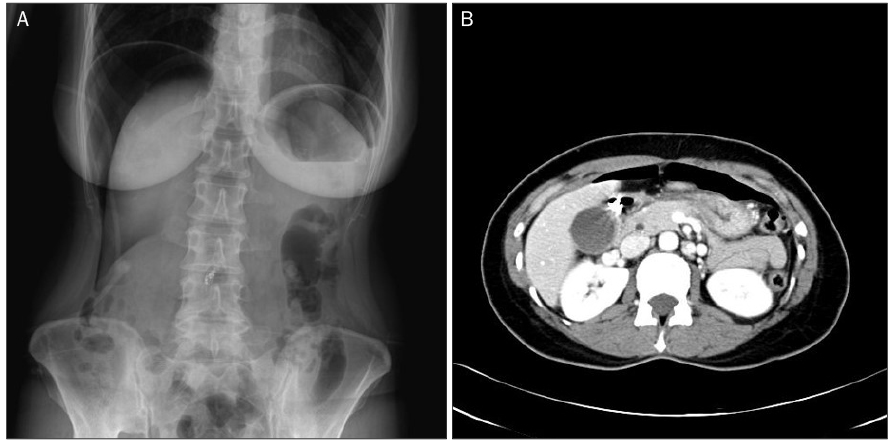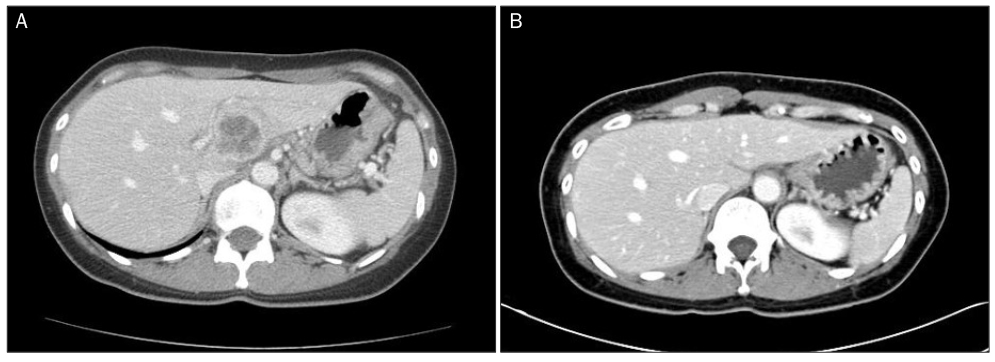Korean J Gastroenterol.
2018 May;71(5):286-289. 10.4166/kjg.2018.71.5.286.
Liver Abscess Secondary to Perforation after Duodenal Endoscopic Resection
- Affiliations
-
- 1Division of Gastroenterology, Department of Internal Medicine, Pusan National University Yangsan Hospital, Pusan National University School of Medicine, Yangsan, Korea. endoksj@gmail.com
- 2Research Institute for Convergence of Biomedical Science and Technology, Pusan National University Yangsan Hospital, Yangsan, Korea.
- 3Department of Radiology, Pusan National University Yangsan Hospital, Pusan National University School of Medicine, Yangsan, Korea.
- KMID: 2415487
- DOI: http://doi.org/10.4166/kjg.2018.71.5.286
Abstract
- Duodenal perforation is a complication of endoscopic mucosal resection. Liver abscess secondary to iatrogenic perforation is extremely rare. A 43-year-old female visited the hospital to remove a sub-epithelial tumor on the duodenal bulb. After endoscopic mucosal resection with band ligation, duodenal perforation occurred. Endoscopic closure was performed successfully using a clipping device to manage duodenal perforation. After 4 weeks, the patient visited our outpatient clinic due to abdominal pain and fever. Abdominal computed tomography showed liver abscess that involved segment three. Liver abscess was resolved with a 10-week antibiotic treatment. To the best of our knowledge, no case of liver abscess secondary to duodenal perforation by endoscopic resection was reported to date in Korea. Here, we report a case of liver abscess caused by a duodenal perforation after endoscopic mucosal resection.
MeSH Terms
Figure
Reference
-
1. Huang CJ, Pitt HA, Lipsett PA, et al. Pyogenic hepatic abscess. Changing trends over 42 years. Ann Surg. 1996; 223:600–607.2. Heathfield KWG, Lond MB. Liver abscess following perforated duodenal ulcer. Lancet. 1942; 240:155.
Article3. Kim DH, Lee CH, Jung HK. A case of subcapsular liver abscess secondary to perforating ulcer of gastric cancer. Korean J Gastroenterol. 2010; 56:109–113.
Article4. Chintamani , Singhal V, Lubhana P, Durkhere R, Bhandari S. Liver abscess secondary to a broken needle migration--a case report. BMC Surg. 2003; 3:8.
Article5. Kadowaki Y, Tamura R, Okamoto T, Mori T, Mori T. Ruptured hepatic abscess caused by fish bone penetration of the duodenal wall: report of a case. Surg Today. 2007; 37:1018–1021.
Article6. Jimenez-Fuertes M, Moreno-Posadas A, Ruíz-Tovar J, Durán-Poveda M. Liver abscess secondary to duodenal perforation by fishbone: report of a case. Rev Esp Enferm Dig. 2016; 108:42.7. Allard JC, Kuligowska E. Percutaneous treatment of an intrahepatic abscess caused by a penetrating duodenal ulcer. J Clin Gastroenterol. 1987; 9:603–606.8. Voermans RP, Le Moine O, von Renteln D, et al. Efficacy of endoscopic closure of acute perforations of the gastrointestinal tract. Clin Gastroenterol Hepatol. 2012; 10:603–608.
Article9. Park YM, Cho E, Kang HY, Kim JM. The effectiveness and safety of endoscopic submucosal dissection compared with endoscopic mucosal resection for early gastric cancer: a systematic review and metaanalysis. Surg Endosc. 2011; 25:2666–2677.
Article10. Ohkuwa M, Hosokawa N, Boku N, Ohtu A, Tajiri H, Yoshida S. New endoscopic treatment for intramucosal gastric tumors using an insulated-tip diathermic knife. Endoscopy. 2001; 33:221–226.
Article11. Kaneko T, Akamatsu T, Shimodaira K, et al. Nonsurgical treatment of duodenal perforation by endoscopic repair using a clipping device. Gastrointest Endosc. 1999; 50:410–413.
Article12. Bertel CK, van Heerden JA, Sheedy PF 2nd. Treatment of pyogenic hepatic abscesses. Surgical vs percutaneous drainage. Arch Surg. 1986; 121:554–558.13. Choi CS, Seo GS, Cho EY, et al. Comparison of pyogenic liver abscesses based on the origin of infection. Korean J Med. 2008; 75:60–67.14. Maher JA Jr, Reynolds TB, Yellin AE. Successful medical treatment of pyogenic liver abscess. Gastroenterology. 1979; 77:618–622.
Article
- Full Text Links
- Actions
-
Cited
- CITED
-
- Close
- Share
- Similar articles
-
- A Case of Liver Abscess Associated with Duodenal Perforation by a Toothpick
- Retroperitoneal Duodenal Perforation Following a Endoscopic Sphincterotomy: A case report
- Two Cases of Successful Clipping Closure of Iatrogenic Duodenal Perforation Occurred during Endoscopic Procedure
- Endoscopic Suturing for the Prevention and Treatment of Complications Associated with Endoscopic Mucosal Resection of Large Duodenal Adenomas
- A Case of Recurrent Liver Abscess Due to Choledochoduodenal Fistula




